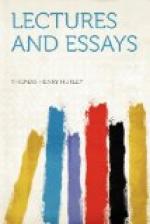The substance which is thus active is a mass of protoplasm, and its activity differs in detail, rather than in principle, from that of the protoplasm of the nettle. Under sundry circumstances the corpuscle dies and becomes distended into a round mass, in the midst of which is seen a smaller spherical body, which existed, but was more or less hidden, in the living corpuscle, and is called its nucleus. Corpuscles of essentially similar structure are to be found in the skin, in the lining of the mouth, and scattered through the whole framework of the body. Nay, more; in the earliest condition of the human organism, in that state in which it has but just become distinguishable from the egg in which it arises, it is nothing but an aggregation of such corpuscles, and every organ of the body was, once, no more than such an aggregation.
Thus a nucleated mass of protoplasm turns out to be what may be termed the structural unit of the human body. As a matter of fact, the body, in its earliest state, is a mere multiple of such units; and in its perfect condition, it is a multiple of such units, variously modified.
But does the formula which expresses the essential structural character of the highest animal cover all the rest, as the statement of its powers and faculties covered that of all others? Very nearly. Beast and fowl, reptile and fish, mollusk, worm, and polype, are all composed of structural units of the same character, namely, masses of protoplasm with a nucleus. There are sundry very low animals, each of which, structurally, is a mere colourless blood-corpuscle, leading an independent life. But at the very bottom of the animal scale, even this simplicity becomes simplified, and all the phaenomena of life are manifested by a particle of protoplasm without a nucleus. Nor are such organisms insignificant by reason of their want of complexity. It is a fair question whether the protoplasm of those simplest forms of life, which people an immense extent of the bottom of the sea, would not outweigh that of all the higher living beings which inhabit the land put together. And in ancient times, no less than at the present day, such living beings as these have been the greatest of rock builders.
What has been said of the animal world is no less true of plants. Embedded in the protoplasm at the broad, or attached, end of the nettle hair, there lies a spheroidal nucleus. Careful examination further proves that the whole substance of the nettle is made up of a repetition of such masses of nucleated protoplasm, each contained in a wooden case, which is modified in form, sometimes into a woody fibre, sometimes into a duct or spiral vessel, sometimes into a pollen grain, or an ovule. Traced back to its earliest state, the nettle arises as the man does, in a particle of nucleated protoplasm. And in the lowest plants, as in the lowest animals, a single mass of such protoplasm may constitute the whole plant, or the protoplasm may exist without a nucleus.




